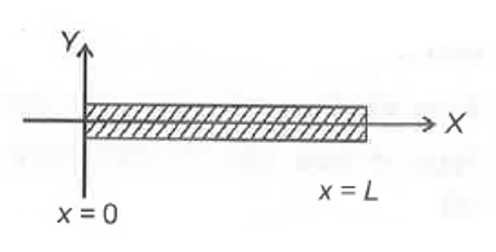A thin bar of length L has a mass per unit length λ, that increases linerarly with distance from one end. If its total mass is M and its mass per unit length at the lighter end is λ0, then the distance of the centre of mass from the lighter end is
L2−λ∘L24M
L3+λ∘L28M
L3+λ∘L24M
2L3−λ∘L26M
The correct Answer is:C
Step by step video, text & image solution for A thin bar of length L has a mass per unit length lambda, that increases linerarly with distance from one end. If its total mass is M and its mass per unit length at the lighter end is lambda_(0), then the distance of the centre of mass from the lighter end is by Physics experts to help you in doubts & scoring excellent marks in Class 12 exams.
Topper's Solved these Questions
- BOOK - DISHA PUBLICATIONCHAPTER - SYSTEM OF PARTICLES & ROTATIONAL MOTION EXERCISE - EXERCISE-1 : CONCEPT BUILDER58videos
SYSTEM OF PARTICLES & ROTATIONAL MOTION
- BOOK - DISHA PUBLICATIONCHAPTER - SEMICONDUCTOR ELECTRONICS : METERIALS, DEVICES AND SIMPLE CIRCUITSEXERCISE - EXERCISE -2: CONCEPT APPLICATOR25videos
SEMICONDUCTOR ELECTRONICS : METERIALS, DEVICES AND SIMPLE CIRCUITS
- BOOK - DISHA PUBLICATIONCHAPTER - THERMAL PROPERTIES OF MATTER EXERCISE - Exercise-2 (Concept Applicator)28videos
THERMAL PROPERTIES OF MATTER
Similar Questions
The mass per unit length (λ) of a non-uniform rod varies linearly with distance x from its one end accrding to the relation, λ=αx, where α is a constant. Find the centre of mass as a fraction of its length L.
View SolutionThe centre of mass of a non-uniform rod of length L whose mass per unit length λ is proportional to x2, where x is distance from one end
 View Solution
View Solution
Knowledge Check
- Question 1 - Select One
A rod of length 3 m has its mass per unit length directly proportional to distance x from one of its ends then its centre of gravity from that end will be at
A1.5 mB2 mC2.5 mD3.0 m - Question 2 - Select One
A rod of length L is of non uniform cross-section. Its mass per unit length varies linearly with distance from left end. Then its centre of mass from left end is at a distance. (Take linear density at left end=0).
 AL3BL6CL2D2L3
AL3BL6CL2D2L3 - Question 3 - Select One
Mass is non-uniformly distributed over the rod of length l, its linear mass density varies linearly with length as λ=kx2. The position of centre of mass (from lighter end) is given by-
A2l/5B3/lC3l/4D2l/3
The mass of an uniform ladder of length l increases uniformly from one end A to the other end B,
find the position of the centre of mass from end A.View SolutionA thin rod AB of length a has variable mass per unit length ρ0(1+xa) where x is the distance measured from A and ρ0 is a constant.
Find the mass M of the rod.View SolutionThe linear density of a thin rod of length 1m lies as λ=(1+2x), where x is the distance from its one end. Find the distance of its center of mass from this end.
View SolutionA non–uniform thin rod of length L is placed along x-axis as such its one of ends at the origin. The linear mass density of rod is λ=λ0x. The distance of centre of mass of rod from the origin is :
View SolutionA rod of length 3m and its mass par unit length is directly proportional to the distance x from its one end . The centre of gravity of the rod from that end will be at :-
View Solution

